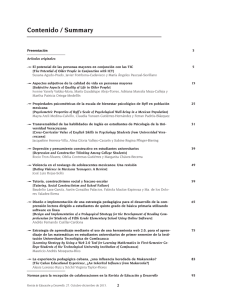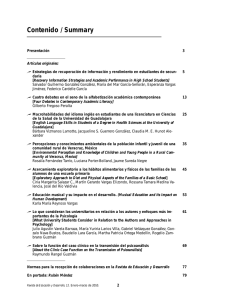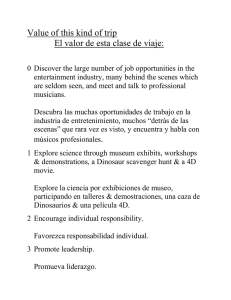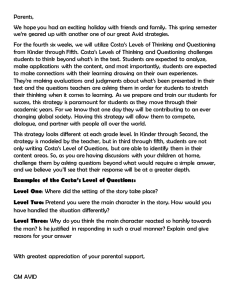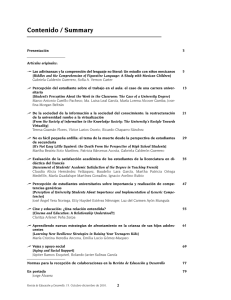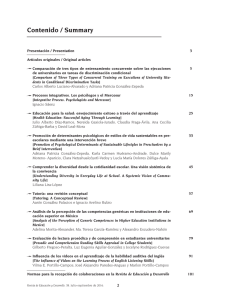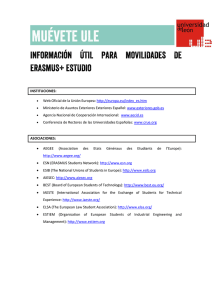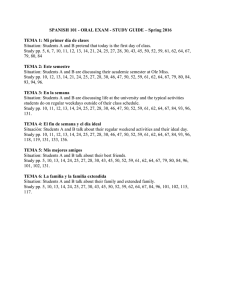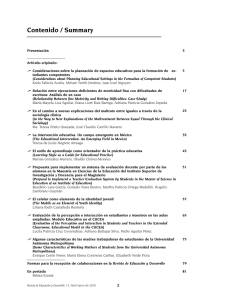Manos a la obra - tadamsspanishahs
Anuncio
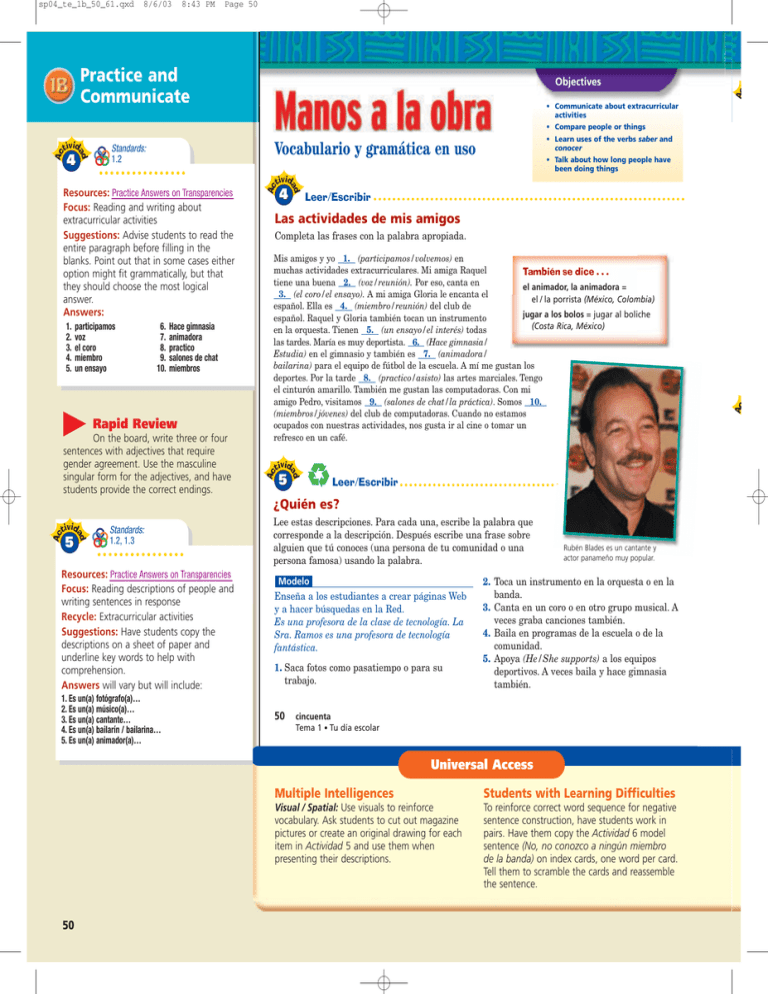
8:43 PM Page 50 Practice and Communicate Ac ad tivid 4 Manos a la obra Vocabulario y gramática en uso Standards: 1.2 •••••••••••••••• participamos voz el coro miembro un ensayo 6. 7. 8. 9. 10. Hace gimnasia animadora practico salones de chat miembros Rapid Review Ac 4 • Learn uses of the verbs saber and conocer • Talk about how long people have been doing things Leer/Escribir Completa las frases con la palabra apropiada. Mis amigos y yo 1. (participamos/volvemos) en muchas actividades extracurriculares. Mi amiga Raquel También se dice . . . tiene una buena 2. (voz/reunión). Por eso, canta en el animador, la animadora = 3. (el coro/el ensayo). A mi amiga Gloria le encanta el el / la porrista (México, Colombia) español. Ella es 4. (miembro/reunión) del club de jugar a los bolos = jugar al boliche español. Raquel y Gloria también tocan un instrumento (Costa Rica, México) en la orquesta. Tienen 5. (un ensayo/el interés) todas las tardes. María es muy deportista. 6. (Hace gimnasia/ Estudia) en el gimnasio y también es 7. (animadora/ bailarina) para el equipo de fútbol de la escuela. A mí me gustan los deportes. Por la tarde 8. (practico/asisto) las artes marciales. Tengo el cinturón amarillo. También me gustan las computadoras. Con mi amigo Pedro, visitamos 9. (salones de chat/la práctica). Somos 10. (miembros/jóvenes) del club de computadoras. Cuando no estamos ocupados con nuestras actividades, nos gusta ir al cine o tomar un refresco en un café. tivid ad On the board, write three or four sentences with adjectives that require gender agreement. Use the masculine singular form for the adjectives, and have students provide the correct endings. • Compare people or things Las actividades de mis amigos Ac 1. 2. 3. 4. 5. • Communicate about extracurricular activities tivid ad Resources: Practice Answers on Transparencies Focus: Reading and writing about extracurricular activities Suggestions: Advise students to read the entire paragraph before filling in the blanks. Point out that in some cases either option might fit grammatically, but that they should choose the most logical answer. Answers: Objectives Ac 8/6/03 5 Leer/Escribir ¿Quién es? Ac ad tivid 5 Standards: 1.2, 1.3 •••••••••••••••• Resources: Practice Answers on Transparencies Focus: Reading descriptions of people and writing sentences in response Recycle: Extracurricular activities Suggestions: Have students copy the descriptions on a sheet of paper and underline key words to help with comprehension. Answers will vary but will include: 1. Es un(a) fotógrafo(a)… 2. Es un(a) músico(a)… 3. Es un(a) cantante… 4. Es un(a) bailarín / bailarina… 5. Es un(a) animador(a)… Lee estas descripciones. Para cada una, escribe la palabra que corresponde a la descripción. Después escribe una frase sobre alguien que tú conoces (una persona de tu comunidad o una persona famosa) usando la palabra. Modelo Enseña a los estudiantes a crear páginas Web y a hacer búsquedas en la Red. Es una profesora de la clase de tecnología. La Sra. Ramos es una profesora de tecnología fantástica. 1. Saca fotos como pasatiempo o para su trabajo. 50 Rubén Blades es un cantante y actor panameño muy popular. 2. Toca un instrumento en la orquesta o en la banda. 3. Canta en un coro o en otro grupo musical. A veces graba canciones también. 4. Baila en programas de la escuela o de la comunidad. 5. Apoya (He/She supports) a los equipos deportivos. A veces baila y hace gimnasia también. cincuenta Tema 1 • Tu día escolar Universal Access 50 Multiple Intelligences Students with Learning Difficulties Visual / Spatial: Use visuals to reinforce vocabulary. Ask students to cut out magazine pictures or create an original drawing for each item in Actividad 5 and use them when presenting their descriptions. To reinforce correct word sequence for negative sentence construction, have students work in pairs. Have them copy the Actividad 6 model sentence (No, no conozco a ningún miembro de la banda) on index cards, one word per card. Tell them to scramble the cards and reassemble the sentence. Ac sp04_te_1b_50_61.qxd 8/12/03 4:59 PM Page 51 Practice and Communicate Ac ad tivid 6 Hablar En tu escuela Modelo o: o: Estudiante A 1. el club de miembro de la banda. Asiste a los ensayos todos los días. No, no conozco a ningún miembro de la banda. No tenemos banda. Estudiante B 5. el club de 3. las reuniones todos los días las prácticas a menudo los ensayos a veces ¡Respuesta personal! 6. 2. el equipo de 4. el equipo de Focus: Talking about classmates and school activities Suggestions: Before students begin their conversations, have them identify the activities in the Student A bubble and brainstorm words they could use to describe each one using the words in the Student B bubble. Answers will vary. Common Errors: Student may omit the personal a after conocer. Remind them that they must use a when the direct object is a person. tivid Escuchar/Escribir Escucha y escribe Escucha lo que dice una estudiante de Managua, Nicaragua, sobre las actividades extracurriculares allí. Escribe los números del 1 al 5 en una hoja de papel y escribe lo que escuchas. Después indica si estas actividades son populares entre los jóvenes de tu comunidad también. Standards: 1.1 •••••••••••••••• ad 7 6 Ac Ac ad tivid tivid ad A — ¿Conoces a un miembro de la banda? B — Sí, conozco a Ryan Johnston. Es un ¿A quién conoces en tu escuela que participa en actividades extracurriculares? Habla con otro(a) estudiante de estas personas. Ac sp04_te_1b_50_61.qxd 7 Standards: 1.2, 2.1, 4.2 •••••••••••••••• Resources: Audio Program: CD 3, Cap. 1B, Track 6; Resource Book: Cap. 1B, Audio Script; Practice Answers on Transparencies Focus: Listening and writing from dictation about extracurricular activities Suggestions: Play the Audio CD or read the script once without having students write. After completing the dictation, allow students time to revise their sentences. Script and Answers: Las actividades extracurriculares En América Latina, generalmente no hay oportunidades en las escuelas para participar en un coro, equipo deportivo, lecciones de artes marciales u otras actividades después de las clases. Los estudiantes que tienen interés en aprender algún pasatiempo como la fotografía, la música o el baile, van a centros culturales o talleres (workshops) en su comunidad. 1. Las clases de artes marciales son muy populares entre los jóvenes. 2. Muchos estudiantes tienen interés en el coro o la orquesta. 3. El club de ajedrez no es tan popular como el club de fotografía. 4. Visitamos salones de chat para conocer a otros jóvenes. 5. Mis amigos crean páginas Web o hacen búsquedas en la computadora. • ¿Hay centros culturales en tu comunidad? ¿Qué actividades hay allí? cincuenta y uno Capítulo 1B 51 Standards: 1.2, 2.1, 2.2, 4.2 Enriching Your Teaching Culture Note Teacher-to-Teacher Throughout Mexico, talleres have allowed artists and performers to share their ideas and develop their skills. El Centro Municipal de Artes, located in Mazatlán, Mexico, teaches classical and folkloric ballet, orchestra, jazz band, and numerous other workshops. There is also a professional theater for performances. Writing sentences from dictation reinforces correct word order and helps students retain vocabulary. Ask students to write 2–3 sentences about their participation in extracurricular activities. Review their sentences to be sure they are error-free. Have students work in pairs dictating their own sentences and writing their partner’s sentences. Suggestions: Ask students to compare extracurricular activities in the United States with those in Spanish-speaking countries. Answers will vary. 51 8/6/03 8:43 PM Page 52 tivid ad Practice and Communicate Ac sp04_te_1b_50_61.qxd 8 Escribir/Hablar Las actividades populares 1 Escribe tres frases para describir qué actividades haces después de las clases. Usa las actividades del recuadro. Rapid Review Write caminar, comer, escribir, and ir on the board. Ask students to form the present tense of each verb. Después de las clases yo voy a casa y navego en la Red. También tomo lecciones de piano. A veces voy a un club atlético. Standards: 1.1, 1.3 8 •••••••••••••••• Ac ad Writing, Audio & Video Workbook: CD 3, Cap. 1B, Audio Activities 5–6, Tracks 7–8 • Writing, Audio & Video Workbook: Cap. 1B, Writing Activity 10 • Resource Book: Cap. 1B Communicative Activity BLM • la banda el ajedrez el coro En Costa Rica participas después de las clases? B —Ensayo con la orquesta y después voy al club atlético. También tomo clases de artes marciales. 3 Escribe cinco frases sobre las actividades que hacen tus compañeros y tú. Modelo Pablo ensaya con la orquesta. Marisa va a casa y navega en la Red. Ac tivid ad Additional Resources los videojuegos Modelo •••••••••••••••• Focus: Writing and speaking about extracurricular activities Suggestions: Ask students to conduct a class survey about the most popular afterschool activities and have them use the information to answer item 3. Answers will vary. la música la fotografía A —¿En qué actividades extracurriculares Standards: 1.1, 1.3 9 el béisbol la natación 2 Habla con tres estudiantes para saber qué hacen después de las clases. Escribe los nombres de los estudiantes y las actividades que hacen ellos. Focus: Writing and speaking about afterschool activities Recycle: Extracurricular activities Suggestions: For step 2, have students create a T-chart with the headings Nombres and Actividades. Assign step 3 for homework. Answers will vary. tivid la orquesta el hockey 9 A ad Ac tivid Modelo las artes marciales Escribir/Hablar Y tú, ¿qué dices? 1. ¿Qué te gusta más, ser miembro de un club o participar en un deporte? ¿Por qué? 2. ¿Usas la computadora mucho o poco en tu tiempo libre? ¿Para qué usas más la computadora? ¿Cuánto tiempo pasas en línea cada día? 3. ¿Cuáles son las actividades más populares en tu escuela? Describe por qué son populares. 4. ¿Hay suficientes actividades para jóvenes en tu comunidad? ¿Qué otras actividades debe ofrecer (offer)? En Guadalajara, México Block Schedule •••••••••••••••• Have students produce a news program about extracurricular activities at their school. Assign each group one of the activities from the word bank in Actividad 8 and have them interview someone who participates in that activity. Have them find out when the team or club meets, what activities there are, and how one can become a member. Assessment • 52 Prueba 1B-2: Vocabulary production 52 cincuenta y dos Tema 1 • Tu día escolar Universal Access Multiple Intelligences Students with Learning Difficulties Logical / Mathematical: Have students poll classmates about their favorite after-school activity and then graph the results of the poll. Tell them to use their graphs to answer item 3 in Actividad 9. Have students complete Actividad 11 in three steps. First tell them to conjugate the verb so that it agrees with the given subject. Next, have them determine the form of tanto that agrees in gender and number with what is being compared. Finally, have them write the complete sentence. sp04_te_1b_50_61.qxd 8/12/03 5:01 PM Page 53 Practice and Communicate Gramática Making comparisons ¿Recuerdas? To compare people or things that are equal to one another, you use: You already know several ways to compare things and people. Gramática más + adjective + que tan + adjective + como as + adjective + as Presentation menos + adjective + que Standards: 4.1 mayor que / menor que mejor que / peor que [EDs: No Grammar OH?] You also know how to say that someone or something is “the most” or “the least”: To say that things are not equal, you can use the negative. Book: Cap. 1B, Video Script Suggestions: Play the GramActiva Video as an introduction or to reinforce your own presentation. Present the grammar in two parts: comparisons with adjectives and comparisons with nouns. Where possible, use concrete, visual examples of the comparisons to make the concept clearer. el / la / los / las + noun + más / menos + adjective + de el / la / los / las + mejor(es) / peor(es) + noun + de En el club atlético, levantar pesas no es tan popular como correr. • Cecilia cree que hacer gimnasia es la actividad más divertida de la escuela. To say “as much as” or “as many as,” you use: as much + noun + as tantos, -as + noun + como as many + noun + as tivid To learn more about making comparisons, watch the GramActiva video. Hay tantas actrices en el ensayo como actores. 10 Ac Gramática Leer/Escribir Ac tivid ad ad 10 11 Gramática Leer/Escribir Comparaciones En la escuela Estás hablando de personas en tu escuela. Completa las siguientes frases con la palabra apropiada. Todos hacemos comparaciones. Ahora es tu turno. Completa las siguientes frases y usa la forma apropiada de tanto. 1. La canción de Mercedes es ____ (tan / tanta) buena como la de Enrique. 1. yo / (no) tener / amigos(as) / como Luz 3. La voz de Catalina es ____ (tan / tanto) bonita como la voz de Victoria. 4. En la banda no hay ____ (tantos / tan) músicos como en la orquesta. 2. este año nosotros / (no) tener / profesores interesantes / como el año pasado 3. el equipo de fútbol americano / (no) tener / partidos / como el equipo de básquetbol 4. los chicos / (no) tener / oportunidades para hacer gimnasia / como las chicas 5. (no) hay / interés en el club de ajedrez / como en el club de ciencias cincuenta y tres Capítulo 1B 53 Enriching Your Teaching Teacher-to-Teacher Cut out pictures of popular singers, actors or athletes. Make photocopies of the same photo twice, place them side-by-side and have students compare the “identical twins” (gemelos idénticos): Juan es tan alto como su hermano. Ana está tan contenta como su hermana. Have students create a cloze passage describing how the twins always have to have the same things. Have them exchange stories and complete the passages: María tiene 20 discos compactos. Marta tiene _____ discos compactos _____ María. (tantos / como) Check comprehension. Ask: ¿Cuántos discos compactos tiene Marta? Resources: Practice Answers on Transparencies Focus: Choosing appropriate comparative expressions Suggestions: Have students identify whether the word after the parenthesis is an adjective or a noun. Relate that to the information in the explanation above. Answers: 1. tan 2. tan 3. tan 4. tantos tivid Standards: 1.2, 1.3 ad 2. Elena no es ____ (tanta / tan) deportista como Angélica. Standards: 1.2 •••••••••••••••• Mejor . . . que tivid ad Note that tanto agrees in gender and number with what is being compared. Ac tanto, -a + noun + como Resources: Video Program: Cap. 1B; Resource Ac En mi club, levantar pesas es tan popular como correr. 11 •••••••••••••••• Resources: Practice Answers on Transparencies Focus: Writing sentences to compare people and things using tanto Suggestions: Have students make a list of the nouns being compared and write the gender and number next to each word. Allow students to use the list to write their sentences. Answers: 1. Yo (no) tengo tantos amigos / tantas amigas como Luz. 2. Este año nosotros (no) tenemos tantos profesores interesantes como el año pasado. 3. El equipo de fútbol americano (no) tiene tantos partidos como el equipo de básquetbol. 4. Los chicos (no) tienen tantas oportunidades para hacer gimnasia como las chicas. 5. (No) hay tanto interés en el club de ajedrez como en el club de ciencias. 53 53 8:44 PM Page 54 tivid ad Practice and Communicate Ac 8/6/03 Ac sp04_te_1b_50_61.qxd 12 Gramática Hablar ¿Qué piensas de . . . ? 12 Standards: 1.1 •••••••••••••••• Focus: Giving personal opinions to compare two things Recycle: Descriptive adjectives; comparatives Suggestions: Direct attention to the ¿Recuerdas? on p. 53. To encourage variety, tell students to use a different adjective for each theme. Answers will vary. Ac 13 Standards: 1.1, 1.3 •••••••••••••••• Focus: Asking and giving opinions concerning popular activities Recycle: Superlatives, comparisons of inequality Suggestions: For step 1, be sure each student has his or her own copy of the group’s questions to conduct their interviews. Encourage students to use a visual such as a chart or graph when presenting the results in step 3. Answers will vary. Standards: 1.2, 2.1, 2.2, 4.2 1. la música clásica / la música rock 2. el fútbol americano / el fútbol 3. jugar a los bolos / jugar al ajedrez 4. los deportes de verano / los A —¿Qué piensas de la clase de matemáticas y la clase de ciencias? B —Pienso que la clase de matemáticas es tan difícil como la clase de ciencias. ¿Y tú? A —Pienso que la clase de matemáticas es más interesante que la clase de ciencias. Estudiante B 5. hacer gimnasia / practicar las artes marciales 6. practicar la fotografía / crear una página Web deportes de invierno bonito, -a emocionante difícil fácil interesante aburrido, -a ¡Respuesta personal! tivid ad ad tivid Habla con otro(a) estudiante sobre lo que Uds. piensan de los siguientes temas. Usen la expresión tan . . . como y un adjetivo apropiado. Si prefieren, pueden usar también expresiones como más . . . que y menos . . . que para expresar sus opiniones.[ Estudiante A Ac Ac ad tivid Modelo 13 Escribir/Hablar Las actividades más populares 1 Trabaja con otro(a) estudiante. Escriban tres preguntas que pueden hacerles a los otros estudiantes de la clase sobre diferentes categorías de actividades, pasatiempos, deportes y personas. Modelo Para ti, ¿cuál es la actividad extracurricular más importante? En tu opinión, ¿quién es el (la) cantante más talentoso(a) de la escuela? 2 Cada estudiante debe hablar con otros(as) dos compañeros(as) y hacerles las preguntas. Escribe sus respuestas. Trabaja con tu compañero(a) otra vez y comparen las respuestas a sus preguntas. Suggestions: Ask students if soccer is popular at their school. Are there any Spanish-speaking players on the team? Ask students to name professional baseball players who come from Spanish-speaking countries. Have them name the countries. To help students answer the questions, tell them to refer to the models in Actividad 13. Answers will vary. 3 Hagan una presentación sobre las opiniones de sus compañeros de clase. Modelo Muchos estudiantes piensan que la actividad extracurricular más importante es el deporte en equipos. Otros estudiantes dicen que el coro y la banda son tan importantes como los deportes. Los deportes más populares El fútbol es el deporte preferido entre muchos jóvenes hispanohablantes. En la República Dominicana, Puerto Rico, Cuba, Venezuela y otros países, el béisbol es tan popular como el fútbol y muchas veces es el deporte más popular. • ¿Cuáles son los deportes más populares en tu ciudad? Compara estos deportes con los de los jóvenes hispanohablantes. En tu opinión, ¿qué deporte es el mejor? ¿Por qué? 54 cincuenta y cuatro Tema 1 • Tu día escolar Block Schedule ••• •• • • • • • • • • • • • Post pairs of pictures of famous Spanishspeaking baseball players or soccer players throughout the classroom. Have students circulate the different photos through the room and write comparisons about the people in the pictures: Alfonso Soriano es tan talentoso como Sammy Sosa. Call on volunteers to share their comparisons and encourage other students to agree or disagree with the descriptions. 54 Universal Access Heritage Language Learners Multiple Intelligences Students may use más when making comparisons describing something that is better, worse, older, or younger. Point out that más is not necessary with the adjectives mejor, peor, mayor, and menor. Have them practice comparisons using these adjectives by describing their friends and family members. Naturalist: To help reinforce comparisons, have the class go outside and compare things they see. Ask them to describe what they see: Este pajaro es más bonito que el otro. Before leaving the classroom, have students brainstorm a list of things they might find outside (flores, árboles, perros, pajaros). sp04_te_1b_50_61.qxd 8/12/03 5:02 PM Page 55 Practice and Communicate Ac ad tivid 14 Escribir/Hablar Los músicos Mira estos dos cuadros del gran artista colombiano Fernando Botero. ¿En qué sentido (way) son similares? ¿En qué sentido son diferentes? Standards: 1.3, 2.2, 3.1 ad Ac tivid 14 •••••••••••••••• Resources: Voc. & Gram. Transparencies: 2; Fine Art Transparencies; Fine Art Transparencies Teacher’s Guide Los músicos (1979), Fernando Botero Tres músicos (1983), Fernando Botero 1 Copia el diagrama de Venn y escribe Cuadro 1 y Cuadro 2 encima de los círculos según el modelo. Escribe las características diferentes de cada cuadro en el círculo apropiado y las características similares en la intersección de los círculos. Luego escribe tres frases comparando los cuadros. Modelos Cuadro 1 características Los dos Cuadro 2 características nueve músicos músicos grandes tres músicos Los músicos en el primer cuadro son tan grandes como los músicos en el segundo cuadro. 2 Trabaja con un grupo de tres. Lee una de tus frases. En grupo, escriban una comparación de los dos cuadros. Usen las ideas de todos los miembros del grupo. Presenten su comparación a la clase. Modelo Hay más músicos en el primer cuadro que en el segundo cuadro. Fernando Botero es conocido por su estilo de arte único (unique). Es famoso tanto por sus cuadros como por sus esculturas. El pajarru, una escultura de un pájaro, sufrió daños (was damaged) durante una explosión en 1995. Con el material dañado, Botero hizo una nueva escultura y la dedicó a la paz. • Compara esta escultura con los cuadros de Botero. También compara la escultura con las esculturas en tu comunidad. ¿En qué sentido son similares y en qué sentido son diferentes? Más práctica Practice Workbook 1B-5 For: Practice with making comparisons Visit: www.phschool.com Web Code: jdd-0114 cincuenta y cinco Capítulo 1B 55 Enriching Your Teaching Culture Note Teacher-to-Teacher Born on April 19, 1932, in Medellín, Colombia, Fernando Botero is considered to be South America’s finest living artist. He has spoken out against the violence that has plagued his hometown of Medellín for decades. He considers art to be “... a spiritual, immaterial respite from the hardships of life.” Have students search the Internet for other Botero paintings or sculptures. Have them choose one and compare it to the work of one of their favorite artists. Have them use comparisons of equality as well as comparisons of inequality. Have students present their descriptions using visuals downloaded from the Internet. Focus: Writing a comparison of two paintings and presenting the information Suggestions: Make photocopies of a blank Venn diagram and distribute them to students. Have students brainstorm a list of adjectives and nouns they can use to describe the paintings. Write the list on the board and allow students to refer to it when completing their diagram. Answers will vary. Extension: Ask students to decide which of the paintings they like better, and why. Have them write their opinions. You might also use the Fine Arts Transparencies reproduction of Picasso’s Trois musiciens and compare it with Botero’s Los músicos (1975). Standards: 1.2, 2.2, 3.1, 4.2 Suggestions: Explain to students that Botero’s sculpture of a bird was destroyed when a terrorist bomb was detonated underneath it. The blast took place during a street festival, killing 27 people. The artist insisted that the remains of the original sculpture be left standing less than ten feet from the new sculpture. Ask students how the new sculpture represents peace. Answers will vary. Additional Resources Writing, Audio & Video Workbook: CD 3, Cap. 1B, Audio Activity 7, Track 9 • Writing, Audio & Video Workbook: Cap. 1B, Writing Activity 11 • Assessment • Prueba 1B-3: Making comparisons 55 sp04_te_1b_50_61.qxd 8/6/03 8:44 PM Page 56 A Practice and Communicate ¿Recuerdas? The verbs saber and conocer Use the a personal when you use conocer to say you know a person. You already know the present-tense forms of saber and conocer. Saber and conocer both follow the pattern of regular -er verbs in the present tense, but each has an irregular yo form. Presentation Standards: 4.1 Resources: Video Program: Cap. 1B; Resource Book: Cap. 1B, Video Script; Voc. & Gram. Transparencies: 40 (yo) sé (nosotros) (nosotras) sabemos (yo) conozco (nosotros) (nosotras) conocemos (tú) sabes (vosotros) (vosotras) sabéis (tú) conoces (vosotros) (vosotras) conocéis Ud. (él) (ella) sabe Uds. (ellos) (ellas) saben Ud. (él) conoce (ella) Uds. (ellos) (ellas) conocen A Suggestions: Play the GramActiva Video as an introduction or to reinforce your own presentation. Have students practice differentiating between saber and conocer by naming facts, information, people, places, and things, and then asking them to name the verb that would be used. For example: Madrid (conocer), ¿Dónde está Madrid? (saber), Marta (conocer), ¿Cuántos años tiene Marta? (saber). • Guillermo conoce a mi primo Tomás. • Saber means to know facts and information. You can also use saber with the infinitive of another verb to say that you know how to do something. ¿Sabes si tenemos tarea para mañana? • Conocer means to know a person or to be familiar with a place or thing. ¿Conoces al profesor de esta clase? No, no lo conozco. ¿Conoces el club atlético de la calle Ocho? ¿Sabes quién es el director de la banda? Sé jugar al ajedrez. Ac ad tivid 15 Standards: 1.2 To learn more about saber and conocer, watch the GramActiva video. •••••••••••••••• 1. ¿el músico talentoso en la orquesta? (No lo conozco.) 2. ¿la hora del ensayo esta noche? (No lo sé.) 3. ¿cómo grabar un disco compacto en la computadora? (No lo sé.) 4. ¿ese club atlético enfrente de la escuela? (No lo conozco.) 5. ¿el cantante colombiano con la voz bonita? (No lo conozco.) 6. ¿el número de personas que ensaya con la banda? (No lo sé.) Block Schedule ••• •• • • • • • • • • • • • Tell students to write a name, place, or action verb in large letters on a piece of paper. Have them sit in a circle. Ask one student to show his or her word and to call on a classmate. The student chosen says a sentence containing the word and saber or conocer. If the sentence is correct, then the student shows a word and calls on another classmate. If not, he or she leaves the circle. The last student in the circle wins. 56 Sé mucho. tivid Ac ad Resources: Practice Answers on Transparencies Focus: Listening to phrases and deciding whether to use saber or conocer Suggestions: Read the script, one phrase at a time. Ask students to explain why they chose conocer or saber for each item. Script and Answers: 15 Gramática Escuchar/GramActiva Tu profesor(a) quiere saber En una hoja de papel, escribe No lo conozco por un lado y No lo sé por el otro. Tu profesor(a) quiere saber lo que sabes y lo que conoces. Escucha sus frases y contesta cada una en el negativo. Muestra el lado apropiado del papel según lo que dice. No lo sé. 56 No lo conoz co. cincuenta y seis Tema 1 • Tu día escolar Universal Access Students with Special Needs Multiple Intelligences Provide the script for Actividad 15 to hearingimpaired students. Have them label one side of their paper No lo conozco and the other side No lo sé. Ask them to write each sentence on the appropriate side of the paper. Bodily / Kinesthetic: Have students dramatize a conversation based on Actividad 16. Ask one student to play the role of an exchange student asking questions, and another to play the role of a student from the United States answering the questions. 8/12/03 5:03 PM Page 57 Ac ad tivid 16 ¡Hola! Leer/Escribir ¡Qué emocionante! 2 Escríbele una carta por correo electrónico a este estudiante y contesta sus preguntas. Ac ad tivid Gramática Hablar/Escribir ¡Hola! Voy a ser un nuevo estudiante en tu escuela y tengo muchas preguntas. ¿Puedes ayud arme? Yo no 1. nada de tu escuela. ¿Es grande? ¿ 2. tú cuántos estudiantes hay? ¿ 3. tú a muc hos estudiantes? ¿Cómo son? ¿ 4. al director de la escuela? ¿Es muy estricto? ¿ 5. si tiene muchas reglas? ¿ 6. qué tipo de actividades extracurriculares hay en la escuela o comunidad? Soy miembro de una banda en mi comunidad. Toco la trompeta. ¿ 7. tocar algú n instrumento musical? Me gusta salir con mis amigos desp ués de las clases. ¿ 8. muchos lugares bonitos adón de ir? Quiero _9. toda la ciudad donde vives. Escríbeme pronto. Modelo A — ¿Conoces la música de Rubén Blades? B — Sí, la conozco. A — ¿Sabes jugar al vóleibol? B — No, no sé jugar al vóleibol, pero sé •••••••••••••••• Resources: Practice Answers on Transparencies Focus: Reading and writing e-mail messages Suggestions: Have students read Rogelio’s e-mail once before they fill in the blanks. Ask students to complete step 2 on the computer either as homework or in the library and e-mail their responses to you. Answers: tivid Ac 17 Estudiante B 5. Sabes 6. Sabes 7. Sabes 8. Conoces 9. conocer Standards: 1.1, 1.3 ad jugar al fútbol. Estudiante A Standards: 1.2, 1.3 16 Step 1: 1. sé 2. Sabes 3. Conoces 4. Conoces Step 2 answers will vary. Rogelio ¿Conoces a tu compañero(a)? 1 Habla con otro(a) estudiante para conocerlo(la) mejor. Usa el verbo saber o conocer y hazle preguntas. Escribe sus respuestas. tivid ad 1 Imagina que un estudiante de intercambio (exchange student) viene a tu escuela. Completa las frases de su correo electrónico con las formas apropiadas de los verbos saber y conocer. 17 Practice and Communicate Ac sp04_te_1b_50_61.qxd •••••••••••••••• muchos estudiantes en esta escuela un buen club atlético un buen salón de chat para visitar navegar en la Red otras ciudades crear una página Web ¡Respuesta personal! 2 Usa las respuestas de tu compañero(a) y escribe un párrafo sobre él (ella). En el club de computadoras Focus: Speaking with a classmate and writing a paragraph about him or her Suggestions: Pair students with a partner whom they don’t know very well. Before students begin, have them write several questions and use their notes during the interview. Answers will vary. Extension: Arrange to have your class interview students from another Spanish class. Have them meet face to face or write their questions and responses in an e-mail. You may wish to set up a pen pal exchange between classes. ¡Respuesta personal! Modelo Mario es un chico muy talentoso. Sabe jugar al fútbol y al béisbol y sabe usar la computadora. Sabe crear páginas Web y conoce muchos salones de chat . . . Más práctica Practice Workbook 1B-6 For: Practice with saber and conocer Visit: www.phschool.com Web Code: jdd-0115 cincuenta y siete Capítulo 1B Theme Project 57 Students can perform step 4 at this point. (For more information, see p. 14-a.) Additional Resources Enriching Your Teaching Teacher-to-Teacher Have students learn about different cultures and participate in meaningful communication by writing e-mails to pen pals in a Spanishspeaking country. Reaching pen pals via e-mail has grown in popularity across the globe. Anyone with access to the Internet can join various e-mail pen pal programs. Many of these programs emphasize cross-cultural learning and building international friendships. • Writing, Audio & Video Workbook: CD 3, Cap. 1B, Audio Activity 8, Track 10 • Writing, Audio & Video Workbook: Writing Activity 12 Assessment • Prueba 1B-4: Saber and conocer Internet Search Keywords: E-mail + pen + pals 57 sp04_te_1b_50_61.qxd 8/6/03 8:45 PM Page 58 Practice and Communicate Gramática Hace + time expressions Gramática Presentation Suggestions: To emphasize that each grammar structure always follows the same pattern, write on the board: ¿Cuánto tiempo hace que _____ ? and Hace _____ que _____ . Have a volunteer fill in the blanks using a different color and then read the sentences. Erase the filled-in words and call on another volunteer. Continue doing this, pointing out to students that you never erase the basic structure, only the words that filled in the blanks. To ask how long something has been going on, use: To tell how long something has been going on, use: ¿Cuánto tiempo + hace que + present-tense verb? Hace + period of time + que + present-tense verb ¿Cuánto tiempo hace que eres miembro del club atlético? Hace más de dos años que soy miembro del club atlético. How long have you been a member of the athletic club? I’ve been a member of the athletic club for more than two years. ¿Cuánto tiempo hace que Uds. practican con el equipo de básquetbol? Hace tres semanas que practicamos con el equipo de básquetbol. How long have you been practicing with the basketball team? We’ve been practicing with the basketball team for three weeks. Ac ad tivid Ac ad tivid 18 Standards: 1.1, 1.3 •••••••••••••••• Resources: Practice Answers on Transparencies Focus: Writing and speaking about how long something has been going on Suggestions: Help students see how to integrate the activity pictured in each item with the words beneath it. Point out that the expressions of time will be at the beginning of their sentences. Answers: Step 1: 1. Hace diez meses que Pedro toma lecciones de artes marciales. 2. Hace muchos años que Lisa hace gimnasia. 3. Hace un año y medio que Juan y Alberto participan en el coro. 4. Hace dos años que soy miembro del club atlético. 5. Hace un año que Marta es fotógrafa. 6. Hace seis años que tú y yo jugamos al ajedrez. Step 2: 1. ¿Cuánto tiempo hace que Pedro toma lecciones de artes marciales? 2. ¿...Lisa hace gimnasia? 3. ¿...Juan y Alberto participan en el coro? 4. ¿...eres miembro del club atlético? 5. ¿... Marta es fotógrafa? 6. ¿... tú y yo jugamos al ajedrez? 18 Ac ad tivid 1. diez meses / Pedro / tomar lecciones 2. muchos años / Lisa / hacer 4. dos años / yo / ser miembro del club 5. un año / Marta / ser 2 Trabaja con otro(a) estudiante. Pregunta y contesta sobre las actividades de los estudiantes. 3. un año y medio / Juan y Alberto / participar 6. seis años / tú y yo / jugar Modelo A —¿Cuánto tiempo hace que Esteban es miembro del club de computadoras? B —Hace dos años que es miembro del club. cincuenta y ocho Tema 1 • Tu día escolar Universal Access •••••••••••••••• 58 Modelo dos años / Esteban / ser miembro del club Hace dos años que Esteban es miembro del club de computadoras. 1 Escribe seis frases para decir cuánto tiempo hace que estos estudiantes hacen diferentes actividades. Standards: 1.2, 1.3 Focus: Interviewing a classmate about favorite pastimes Recycle: Leisure activities; expressions of time Suggestions: Encourage students to ask questions about how long their partner has done an activity. Have them take notes to use for Actividad 20. Answers will vary. Escribir/Hablar Hace mucho tiempo que . . . 58 19 Gramática Advanced Learners Heritage Language Learners Ask students to write descriptions of sports figures, actors, singers, or other well-known people using hacer + time expressions. Without saying whom they are describing, have students read their description to a partner. The partner tries to guess who is being described and asks follow-up questions if needed. Students may normally use the expressions ¿Hace cuánto trabajas aquí? or ¿Cuánto tiempo llevas trabajando aquí? To respond, they might say: Llevo dos años. Point out that while these are acceptable expressions, students can vary their speech by becoming familiar with the structures taught in the Gramática. sp04_te_1b_50_61.qxd 8/6/03 8:45 PM Page 59 Ac 20 Escribir/Leer/Escuchar Juego Una entrevista Modelo —¿En qué actividades participas? —Me encanta esquiar en el invierno. —¿Cuánto tiempo hace que esquías? —Hace diez años que esquío. Usa la información de la Actividad 19 y escribe una descripción de tu compañero(a). No debes incluir el nombre de tu compañero(a) en la descripción. Pon la descripción en una bolsa. Otro(a) estudiante toma una descripción y la lee delante de la clase. La clase tiene que identificar a quién describe. tivid Standards: 1.2, 1.3 ad 1 Escribe cinco frases sobre tus actividades favoritas y tus pasatiempos. 2 Entrevista a otro(a) estudiante para saber en qué actividades participa y cuándo empezó a practicarlas. Escribe las respuestas de tu compañero(a). Ac Ac Escribir/Hablar ad ad 19 A B A B Practice and Communicate tivid tivid 20 •••••••••••••••• Focus: Writing and listening to descriptions of classmates Recycle: Leisure activities; expressions of time Suggestions: Tell students to write their descriptions. Briefly check that the descriptions are appropriate before they are put in the bag. Answers will vary. Modelo A esta persona le gusta practicar deportes. Hace diez años que . . . Ac ad tivid 21 Leer/Hablar Una cantante famosa 21 2. ¿Cuánto tiempo hace que ella canta y hace películas? Reina1 de la salsa Hace más de 50 años 2 y que el mundo conoce z. Cru ia Cel a ira adm es Esta cantante y actriz los en e viv o per de Cuba 3 Estados Unidos desde los años 60. Todos la conocen por su música de “salsa.” Celia ha discos y ha grabado4 más de 70 ones al Grammy. aci min recibido 18 no mmy en el año Recibió su primer Gra mos a Celia por oce 1989. También con Mambo Kings, una The o com , las sus pelícu e. deras y Armand Assant Ban película con Antonio 5 en el la rel est e hay una Ella es tan famosa qu Otra ood con su nombre. llyw Ho de d var ule Bo “Celia e qu e ria Estefan, dic cantante famosa, Glo sica mú la de u írit esp y el ejemplifica la energía cubana y latina.” 1Queen 2world 3since •••••••••••••••• 1. ¿Por qué conoce el mundo a Celia Cruz? Celia Cruz 4has recorded Standards: 1.2, 2.2 ad Ac tivid Lee esta descripción de una cantante famosa. Después trabaja con otro(a) estudiante para contestar las preguntas. 3. ¿De dónde es Celia? ¿Cuánto tiempo hace que ella vive en los Estados Unidos? 4. ¿Cómo sabemos que Celia es muy famosa? Más práctica Practice Workbook 1B-7 cincuenta y nueve Capítulo 1B 1. La conoce por su música de “salsa.” 2. Hace más de 50 años que ella canta y hace películas. 3. Celia es de Cuba. Hace más de 40 años que Celia vive en los Estados Unidos. 4. Hay una estrella en el Boulevard de Hollywood con su nombre. Additional Resources For: Practice with hace and time expressions Visit: www.phschool.com Web Code: jdd-0116 5star Resources: Practice Answers on Transparencies Focus: Reading about a famous singer Suggestions: Have students read all of the questions before starting the reading. Tell them to look for cognates and context clues to help them understand the article. Answers: 59 • Writing, Audio & Video Workbook: CD 3, Cap. 1B, Audio Activity 9, Track 11 • Writing, Audio & Video Workbook: Writing Activity 13 • Resource Book: Cap. 1B, Communicative Activity BLM Assessment • Prueba 1B-5: Hace + time expressions Enriching Your Teaching Culture Note Internet Search The roots of salsa and mambo lie in the fusion of European and African music. This combination of traditional with creative rhythms developed in the early 1800s, especially in Cuba. Salsa and mambo were introduced to the world by such famous singers as Celia Cruz and Pérez Prado. Keywords: Celia Cruz, música salsa, mambo 59 8/6/03 8:45 PM Page 60 tivid ad Practice and Communicate Ac sp04_te_1b_50_61.qxd 22 Leer/Hablar/Escribir/Dibujar Dibuja una página Web Trabaja con otro(a) estudiante y dibujen una página Web sobre una actividad extracurricular favorita. Standards: 1.3, 3.1 ad Ac tivid 22 •••••••••••••••• Focus: Cross-curricular connection to computer science Suggestions: Brainstorm a list of terms that are useful when talking about the Internet. Explain to students that a storyboard is not just a drawing of their Web site. Tell them that it should include various panels that illustrate how visitors might be able to move around the site and show where various links will take them. You may want to provide the students with a rubric for their presentations. Answers will vary. Exploración del lenguaje Presentation Standards: 4.1 Resources: Practice Answers on Transparencies Suggestions: Students will often pronounce words with -ción endings like their English cognates. Point out the accent mark to students and have them practice by saying the -ción words in the ¡Compruébalo! aloud. Ask them to tell you the English equivalent of the refrán. (Business before pleasure) Para crear una página Web, pueden empezar a trabajar sin usar una computadora. Dibujen un tablero (storyboard) para la página principal. Decidan cómo van a ilustrar la página y qué enlaces (links) van a tener. Preparen una presentación de su página Web. Usen la página Web de la Escuela Secundaria Vallejo como modelo. *Equipment Trabaja con tu compañero(a) y comparen la página Web que Uds. dibujaron con una verdadera página Web de deportes. Luego contesta las siguientes preguntas. 2. ¿Qué información no tiene tu página Web? 3. ¿Qué puedes cambiar para dibujar una página Web mejor? Exploración del lenguaje Nouns and verbs In Spanish, you can turn some verbs into nouns by dropping the final r of the infinitive and adding -ción. The -ción ending is equivalent to the -tion ending in English. The nouns formed in this way are feminine: decorar ➞ la decoración Answers: celebración explicación observación participación 1. ¿Qué información tienen las dos páginas? ¿Qué otra información tiene la verdadera página Web? ¡Compruébalo! What are the corresponding nouns for each of the following verbs? celebrar 60 comunicación presentación graduación repetición Refrán preparar ➞ la preparación comunicar graduar presentar repetir And what are the corresponding verbs for these nouns? Primero la obligación y entonces la celebración. explicar observar participar sesenta Tema 1 • Tu día escolar Universal Access 60 Heritage Language Learners Multiple Intelligences Have students prepare a written review of a Spanish-language Web site dedicated to their favorite extracurricular activity. Ask them to describe the site, to tell you what they like and don’t like about the site, and to include a printout of the site’s homepage. Visual / Spatial: For Actividad 22, bring in hard copies of sample Web pages about activities mentioned in the chapter, such as martial arts or orchestra music. Point out the features, layout, and links. Ask students to use the samples to decide what they would like to highlight to attract readers to their Web page. sp04_te_1b_50_61.qxd 8/6/03 8:45 PM Page 61 Practice and Communicate Ac ad tivid 23 Leer/Escribir/Hablar Un anuncio Lee el folleto (brochure) del Club Deportivo Acuasol. Luego contesta las preguntas con otro(a) estudiante. ¡Club Deportivo Acuasol! Ac 23 Ofrecemos: Resources: Voc. & Gram. Transparencies: 41; Practice Answers on Transparencies Focus: Reading and demonstrating comprehension of a brochure for a sports club Suggestions: Remind students to use visual clues to help them understand the reading. If they are not familiar with a club and are not members of a club, have them answer items 4 and 5 using information found on the Internet about a sports club in a Spanish-speaking country. Answers will vary but will include: Cultura Básquetbol Danza regional Jazz Un estilo de vida asol, En el Club Deportivo Acu a nuestra tenemos una misión: dar ble ada agr r luga un comunidad al y la para el ejercicio person a través integración de la familia, ión y del* deporte, la recreac ofrecer la cultura, con el fin de vida. En el bienestar y calidad de l hay una Club Deportivo Acuaso o culturales variedad de cursos tant rentes dife en , vos orti dep o com ana. sem la de s horarios y día stras La mayor parte de nue sin ce ofre actividades se bién Tam al. costo adicion ro, tenemos parqueade o. cafetería y ser vicio médic hoy de des ieza Por eso, emp liar a cuidar tu salud y a amp y les ura cult tes tus horizon . . . el en í aqu s sociale ¡Club Deportivo Acuasol! Gimnasia reductiva Natación Tae Kwon Do Tai Chi Chuan Tenis Standards: 1.2, 2.2, 3.2, 4.2 •••••••••••••••• Aeróbicos Ballet Deporte ad Bienvenidos tivid 1. Este folleto es de un club deportivo. 2. En el Club Deportivo Acuasol hay muchas actividades deportivas, culturales y de recreo, y también hay parqueadero, cafetería y servicio médico. 3. Answers will vary. 4. Answers will vary. 5. Answers will vary. Recreación Yoga Taller de teatro Squash Coro Extension: Have students write responses to the following: Imagina que eres miembro del Club Deportivo Acuasol. ¿En qué actividades te gusta participar? ¿Por qué? *through 1. ¿Para qué es este folleto? 2. ¿Qué servicios hay en el Club Deportivo Acuasol? 3. ¿Te gustaría ser miembro de este club? ¿Por qué? 4. ¿Conoces un club atlético en tu comunidad? ¿Tiene ese club tantos servicios diferentes como el Club Deportivo Acuasol? Compara los dos clubes. 5. ¿Eres miembro de algún club? ¿Cómo se llama? ¿Cuánto tiempo hace que eres miembro del club? El español en la comunidad La salsa es uno de los bailes más populares entre los hispanohablantes. Hoy en día, muchas veces uno puede encontrar (find) clases que enseñan este baile en varios lugares dentro de la comunidad. Busca en el periódico o en tu comunidad o en una comunidad cerca lugares que ofrecen clases de salsa. • ¿Te gustaría aprender a bailar salsa como actividad extracurricular? ¿Por qué? sesenta y uno Capítulo 1B Enriching Your Teaching Culture Note Internet Search Several Spanish-language search engines exist to help Spanish-speaking surfers navigate the Web. Many popular search engines have sites that are specific to various Spanish-speaking countries. The Internet is an important tool for students studying Spanish language and culture. Keywords: español + search engines Presentation Standards: 1.2, 5.1 Suggestions: Ask students if they know how to dance salsa. If they do, ask them to demonstrate the dance. Do they know of any places in your community where people go to dance and listen to salsa music? Answers will vary. 61 Additional Resources • Heritage Language Learner Workbook: 1B-3, 1B-4, 1B-5 Theme Project Students can perform step 5 at this point. (For more information, see p. 14-a.) 61
